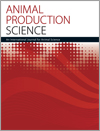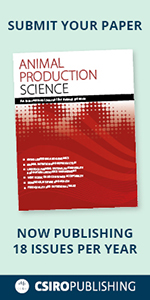
Animal Production Science
Volume 63 Number 2 2023
The overuse of antibiotics in food animals plays an important role in developing drug-resistant bacteria. As a result, food has become a potential vehicle for transmitting drug-resistance bugs from animals to humans. Hence, the current study aimed at assessing and analysing scientific publications on microbiome engineering to control drug-resistant bugs in food-producing animals. Our findings showed that microbiome products have a promising capability to tackle certain drug-resistant bugs and improve animals’ health and productivity.
AN22233 Abstract | AN22233 Full Text | AN22233PDF (674 KB) Open Access Article
AN21155Oleic acid, independent of insulin, promotes differentiation of goat primary preadipocytes in vitro
The present study found that 100 μM oleic acid, independent of insulin, enhanced the triglyceride accumulation and lipid droplet deposition in goat primary intramuscular preadipocytes, and was not affected by supplementation of insulin. Meanwhile, oleic acid significantly increased the expression of peroxisome proliferator-activated receptor gamma, CCAAT enhancer-binding protein alpha and fatty acid binding protein 4, and decreased the expression of lipoprotein esterase. Oleic acid, independent of insulin, may promote goat preadipocyte differentiation via the expression of peroxisome proliferator-activated receptor gamma and CCAAT enhancer-binding protein alpha.
AN21327Weight gain and enteric methane production of cattle fed on tropical grasses
 , S. Marquardt, R. Eckard, A. Sanchez, U. Dickhoefer, L. Merbold, K. Butterbach-Bahl, C. Jones
, S. Marquardt, R. Eckard, A. Sanchez, U. Dickhoefer, L. Merbold, K. Butterbach-Bahl, C. Jones  , M. Robertson-Dean and J. Goopy
, M. Robertson-Dean and J. Goopy 
Cultivated grasses are an important feed resource for smallholder livestock keepers in East Africa, but animal performance studies when using these forages are limited and inconclusive. We measured growth rate and enteric methane production in growing Boran steers fed either Napier, Rhodes or Brachiaria and observed similar daily weight gains of about 0.5 kg and a higher methane production than currently estimated for high-forage diets. This implies up to 20% underestimation of enteric methane production by cattle in the region.
AN21327 Abstract | AN21327 Full Text | AN21327PDF (1.1 MB) Open Access Article
Spirulina platensis (SP) is an essential dietary supplement for boosting animal growth performance, having a high protein content (60–70% on a dry-matter basis) with minimal toxicity. Supplementation is needed because of lack of nutritional resources, so as to meet the nutritional needs of goats in Oman; hence, the effect of spirulina in boosting the growth of Omani goat was studied. Feeding spirulina to kids led to increased growth, herd performance and buck selection facilitation at an earlier age.
AN21483 Abstract | AN21483 Full Text | AN21483PDF (535 KB) Open Access Article
AN22142Strain differences in effects of dietary supplementation with Aspergillus niger cultures in protein-reduced diets on performance, plasma biochemistry and meat lipid oxidation of broilers
 , Shaban Rahimi, Abdolhossein Dalimi Asl and Hamid Raei
, Shaban Rahimi, Abdolhossein Dalimi Asl and Hamid Raei
Two strains of Aspergillus niger were tested for production of fermented wheat bran as a dietary supplement for poultry. Application of A. niger cultured wheat bran in reduced-protein diets had positive impacts on growth performance, carcass characteristics, blood parameters, meat malondialdehyde content, and ileal microflora population. The two strains of A. niger produced similar outcomes in many results; however, in some parameters such as ileal microbiota population, A. niger 2 induced a better response.
AN22287Sheep grazing Trigonella balansae had productivity, health and meat quality similar to sheep grazing subterranean clover or French serradella
 , Joshua Hendry, Paul Young, Elizabeth Hulm, Andrew Toovey, Jane Speijers and Robert Harrison
, Joshua Hendry, Paul Young, Elizabeth Hulm, Andrew Toovey, Jane Speijers and Robert Harrison
Trigonella balansae is a novel species that is being domesticated for use in Australian pasture systems. As part of a duty of care experiment, we compared productivity, health and meat quality of sheep grazing the novel Trigonella accession with sheep grazing French serradella and subterranean clover. While there were some differences in pasture composition, plant nutritional value and animal health, Trigonella did not vary significantly from other species in terms of feeding value.
AN22287 Abstract | AN22287 Full Text | AN22287PDF (1.3 MB) Open Access Article
The ever increasing world population is putting intense pressure on the animal production sector to increase sheep and mutton production. In sheep-feeding systems, most feed sources are becoming expensive due to the effects of recurring droughts and climate change, necessitating exploration of alternative cheap feed sources. Observations from the study showed that ammoniated maize stover, an alternative feed source, may be successfully incorporated into sheep-feeding systems without a reduction in sheep production performance
AN22050Technical and economic analysis, and benchmarking associated with dairy farms in Minas Geraiz, Brazil

The evaluation of technical and economic indexes, and the establishment of benchmarking are important for the financial management of dairy operations. We studied a broad spectrum of dairy farms, and analysed which indicators vary the most in high, intermediate and low return on assets’ farms. Lastly, we demonstrated the importance of categorising technical and financial indexes to create new benchmarks by region, and that this analysis must be periodically performed, aiming for greater profit.
AN22043The effect of transferring dairy cows from a group housing system to individual pens for research purposes on behaviour and milk yield
 and Daniel Enriquez-Hidalgo
and Daniel Enriquez-Hidalgo 
This study investigated how transferring dairy cows from a group housing system into individual pens affected their behaviour and milk production. Cow behaviour was evaluated before the transfer, immediately after the transfer, after 5 weeks in the individual pens and on return to the group housing system. Milk yield was recorded daily. The observed changes in cow behaviour seemed to reflect attempts to adapt to the new environment and did not seem to be detrimental to the major research.



